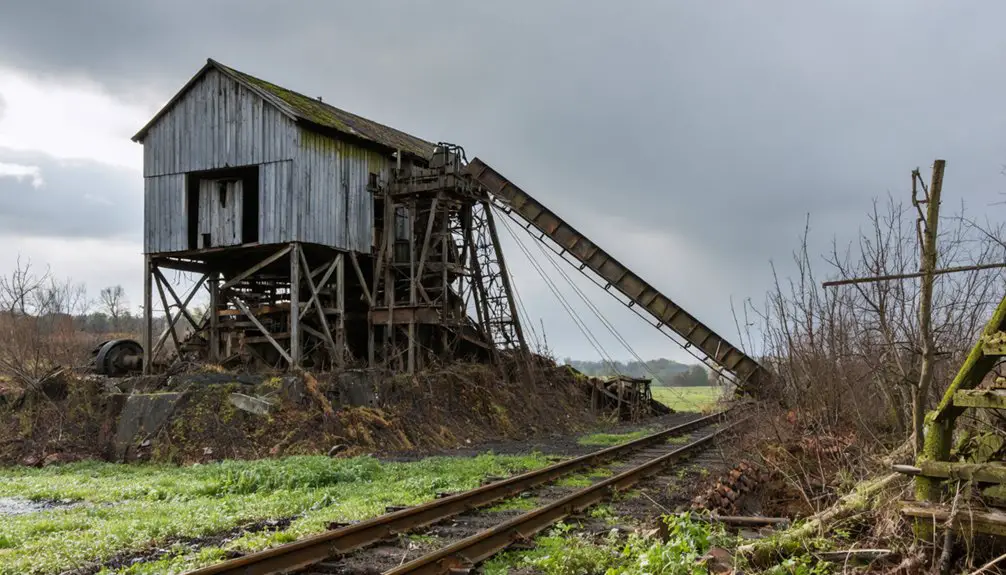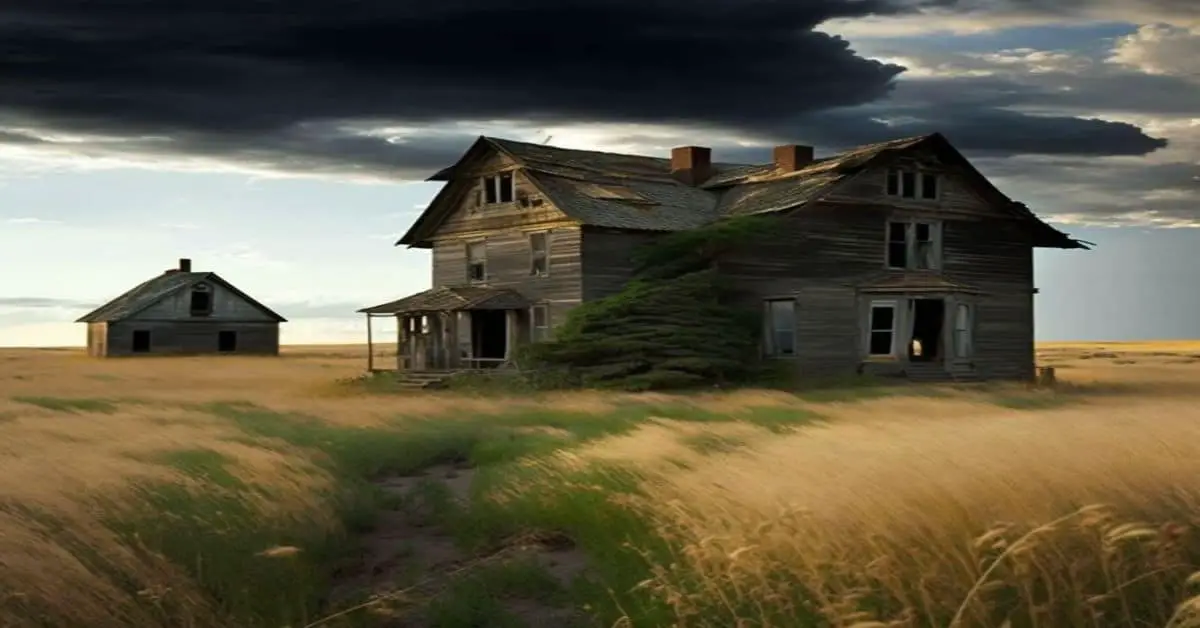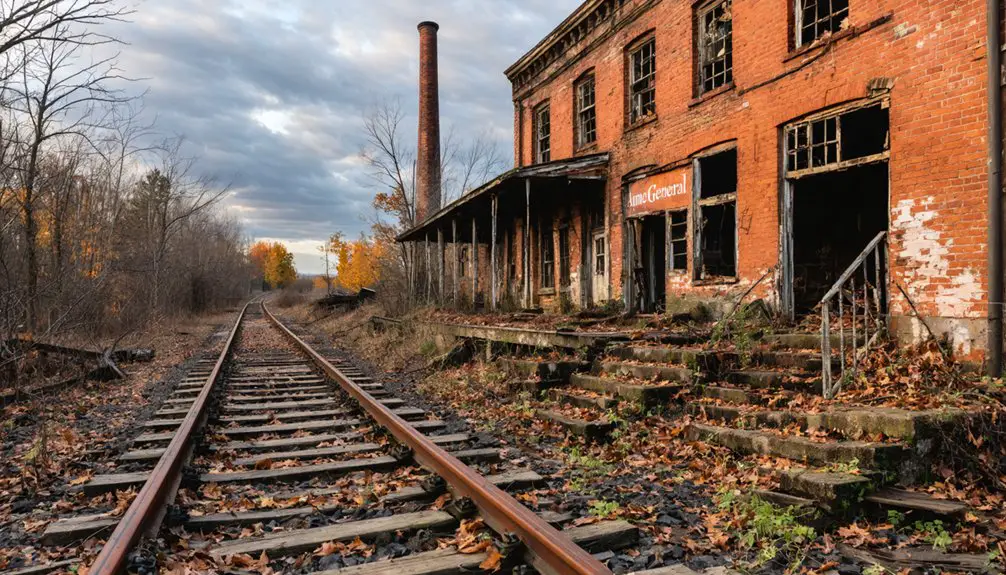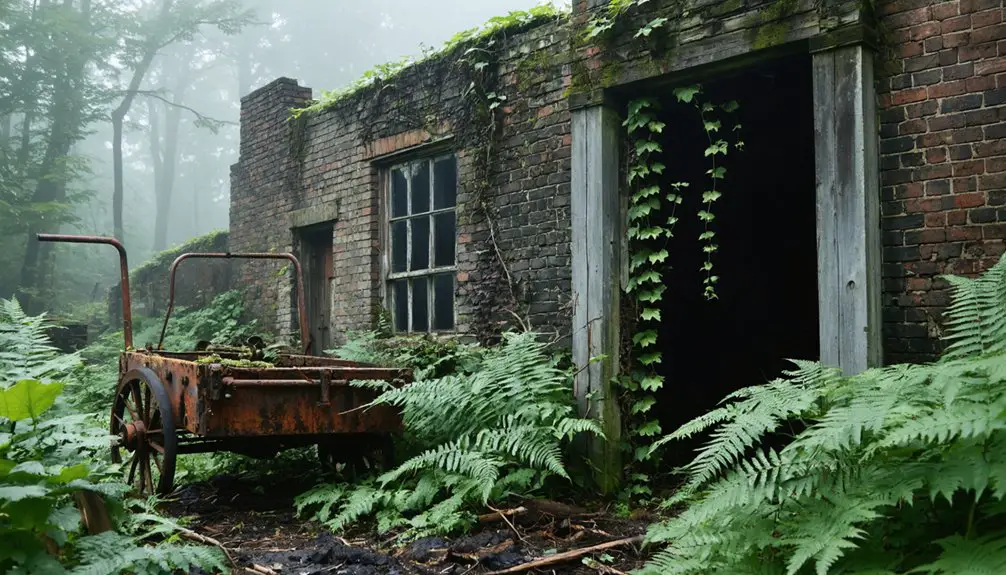You’ll find Meco, Pennsylvania as a haunting ghost town, transformed from a thriving coal mining settlement that once housed 1,200 residents. In May 1962, an underground mine fire sparked its dramatic decline, releasing toxic gases and creating dangerous sinkholes throughout the area. Today, only five residents remain among crumbling buildings and abandoned streets, while beneath the surface, coal still burns at temperatures exceeding 900 degrees Fahrenheit. The town’s rich mining heritage holds deeper secrets within its scarred landscape.
Key Takeaways
- Meco transformed from a thriving coal mining town to a ghost town after an underground mine fire started in 1962.
- The town’s population plummeted from 1,000 in 1980 to just five residents by 2020 following a $42 million government buyout.
- Most buildings were condemned and demolished after Governor Bob Casey’s 1992 eminent domain declaration.
- The ongoing underground fire releases toxic gases, creates sinkholes, and maintains temperatures exceeding 900 degrees Fahrenheit beneath the surface.
- Only a few structures remain, including the Odd Fellows Cemetery, while cracked streets and overgrown vegetation dominate the landscape.
The Rise of a Mining Settlement
As Pennsylvania’s Coal Region emerged as the world’s largest repository of anthracite coal in the late 18th century, Meco established itself as one of the many mining settlements that would dot the landscape.
You’d find this pioneering community nestled among the rich deposits that contained an estimated seven billion short tons of high-carbon anthracite.
Surrounded by vast reserves of pure anthracite coal, Meco stood as a testament to Pennsylvania’s mineral wealth.
The settlement’s strategic position near early mining operations sparked rapid development as mining technology evolved from basic surface extraction to sophisticated room-and-pillar methods.
The community’s resilience emerged through the establishment of essential infrastructure, including company housing and transportation networks.
When the Lehigh Coal & Navigation Company began commercial shipping in the 1790s, Meco’s growth accelerated, driven by the Industrial Revolution‘s voracious appetite for coal to power factories, railroads, and home heating.
Like many towns in the region, Meco attracted waves of European immigrants who sought opportunity in the mines, contributing to the area’s rich cultural diversity.
The introduction of coke production in the 1850s transformed the local iron manufacturing landscape, further cementing Meco’s industrial importance.
Life in Early Meco
While the coal mines defined Meco’s economic purpose, daily life in the settlement revolved around a close-knit community of several hundred residents, mostly miners and their families.
You’d find family dynamics shaped by long, dangerous workdays, with men spending up to 12 hours underground while women managed households and children attended the local schoolhouse. Community resilience emerged through shared experiences at the company store, church gatherings, and local fairs.
Life wasn’t easy – you’d face limited healthcare, basic infrastructure, and economic uncertainty tied to the mine’s fortunes. Similar to the complex tool development of early Native Americans in the region, miners relied on specialized equipment and techniques to survive their harsh working conditions.
The town’s diverse European immigrant population brought their traditions together, creating a unique cultural blend through festivals and religious observances. Like the religious tolerance that William Penn established in the colony, the community embraced different faiths and customs.
Despite the hardships, residents forged strong bonds through their shared mining heritage and mutual support systems.
The Mining Operations Era
You’ll find Meco’s mining operations relied heavily on room-and-pillar methods typical of early 20th-century Pennsylvania bituminous coal extraction, where miners used hand tools and primitive safety lamps to work the coal face.
The underground workforce endured grueling 10-hour shifts, pushing loaded coal cars through narrow tunnels while contending with constant dangers from roof falls and gas buildup. During strikes in 1894, many miners faced massive evictions and blacklisting for participating in labor actions. As with most mines of this era, the coal recovery rates using the room-and-pillar technique typically ranged between 35% to 70% of available deposits.
Coal production from Meco’s drift mines was transported via mule teams to nearby beehive ovens before being shipped by rail to steel mills throughout western Pennsylvania.
Mining Equipment and Tools
During Meco’s coal mining heyday, miners relied on a combination of basic hand tools and increasingly sophisticated mechanical equipment to extract bituminous coal from the region’s rich seams.
You’d have seen workers wielding picks, shovels, and sledgehammers in the early days, but mining innovations quickly transformed operations. Steam-powered drills and coal cutting machines replaced manual labor, while mine cars pulled by ponies or small locomotives transported coal to the surface.
The equipment evolution brought electric-powered continuous miners, conveyors, and shuttle cars by the early 20th century. Before these advancements, mules drew carts through the mine tunnels to transport coal.
You’ll find it interesting that Meco’s miners also used essential safety gear like cap lamps and gas detection devices, while processing equipment on the surface – from sorting machines to beehive coke ovens – prepared coal for market. Early miners faced significant challenges as iron grates were needed to successfully ignite the coal for use as fuel.
Underground Workforce Daily Life
Life beneath Meco’s surface brought stark challenges for the coal miners who descended into the darkness each day.
You’d find yourself working long hours in confined spaces, maneuvering the room-and-pillar system while facing constant underground hazards. The dry winter air would heighten your risk of deadly methane explosions, while coal dust slowly filled your lungs. The development of technological advancements gradually reduced the need for manual labor underground.
Despite speaking different languages, you’d forge strong miner camaraderie with your diverse coworkers as you tackled these dangers together. Your world revolved around the company town, where the mining operator controlled your housing, stores, and daily existence.
If you survived the immediate threats of roof collapses and machinery accidents, you’d still confront the grinding toll of occupational diseases that claimed countless lives in Pennsylvania’s coal country. The dangerous conditions led to over 70,000 miner deaths between 1880 and 1923 across American coalfields.
Coal Production and Transport
As anthracite coal dominated Meco’s mining operations, the Glen Alden Coal Company established a vast network of 14 collieries that employed 34,000 workers across Pennsylvania’s northeastern coalfields.
You’d find their high-quality anthracite, known for its clean-burning properties and superior energy content, marketed under the “Blue Coal” brand throughout the Northeast.
Coal transportation evolved from early river barges called ‘arks’ on the Lehigh River to an extensive railroad network dominated by the Delaware, Lackawanna and Western Railroad.
Mining logistics centered around efficient movement from pit to market, with purpose-built loading terminals and tipples facilitating transfer to railcars.
This infrastructure helped Meco’s anthracite reach essential industrial centers, supporting steel production and urban heating needs until competition from oil and gas sparked the industry’s decline.
Key Historical Events
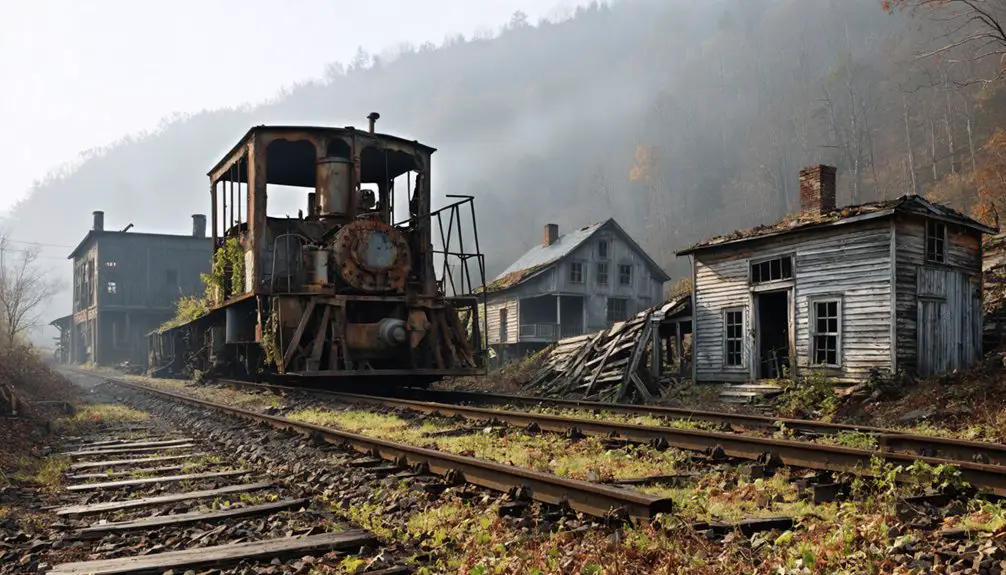
The small mining settlement that would become Meco began taking shape in 1810 with the construction of Reading Road through Pennsylvania’s coal-rich valley.
One of the nation’s founders, Robert Morris, initially owned the land but went bankrupt before development could begin. The area’s historical significance grew as anthracite mining operations expanded, transforming Meco into a thriving coal town of 1,200 residents.
The community’s resilience was tested in May 1962 when a devastating underground coal fire began in an abandoned strip mine.
In a cruel twist of fate, the abandoned mine that once sustained Meco became the force that would destroy it.
You’ll find this fire still burns today, having forced most residents to relocate by the 1980s after Congress approved a $42 million buyout.
Despite the exodus, some determined residents refused to leave, though the town’s population had dwindled to just 63 by 1990.
The Decline and Abandonment
Since igniting in 1962, an underground coal fire sparked Meco’s dramatic transformation from thriving mining town to virtual ghost town. The fire spread through coal seams beneath the town, releasing toxic gases and creating dangerous sinkholes up to 150 feet deep.
You’ll find that government actions intensified in the 1980s when federal authorities stepped in due to mounting safety concerns.
The population reduction was stark – from 1,000 residents in 1980 to just five by 2020. Governor Bob Casey’s 1992 eminent domain declaration condemned all buildings, while a controversial buyout program relocated most inhabitants.
Architectural Remnants
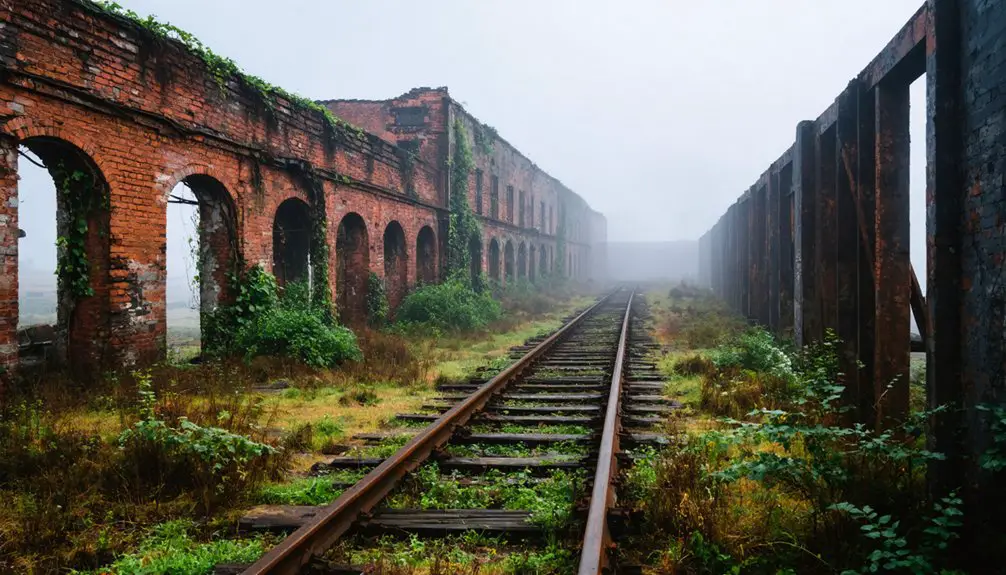
Remnants of Meco’s architectural heritage tell a haunting story of urban decline, with most structures now demolished by the Columbia County Redevelopment Authority.
You’ll find architectural decay everywhere you look – from crumbling sidewalks to overgrown streets that lead nowhere. The town’s final standing houses required brick buttresses after neighboring structures were torn down, a stark reminder of how the townhouses once supported each other structurally.
- Odd Fellows Cemetery stands as one of the few preserved landmarks, its wrought iron fence enclosing generations of community memory
- Cracked streets peek through wild vegetation, creating an eerie blend of urban ruins and nature
- Churches remain as silent sentinels of the town’s former liveliness
- Apple trees now grow where homes once stood, marking preservation efforts
- Brick buttresses support the last remaining houses, evidence of the town’s structural interdependence
Environmental Legacy
Deep beneath Meco’s abandoned streets lies a toxic legacy of industrial negligence and environmental devastation.
You’ll find hazardous waste contamination stretching back over 40 years, with rusted containers and untreated waste seeping into the soil. The environmental impact extends to Sewickley Creek, where treated wastewater discharges have left visible foam and yellow discoloration.
The region’s toxic legacy is compounded by an underground coal fire that’s burned since 1962, releasing dangerous gases like carbon monoxide and destabilizing the ground.
You’ll notice temperatures beneath the surface sometimes exceed 900 degrees Fahrenheit. Despite $42 million in federal cleanup funds and various regulatory efforts, the contamination persists.
The area’s continuing environmental challenges have forced residents to relocate, leaving behind a stark reminder of industrial-era consequences.
Local Legends and Stories
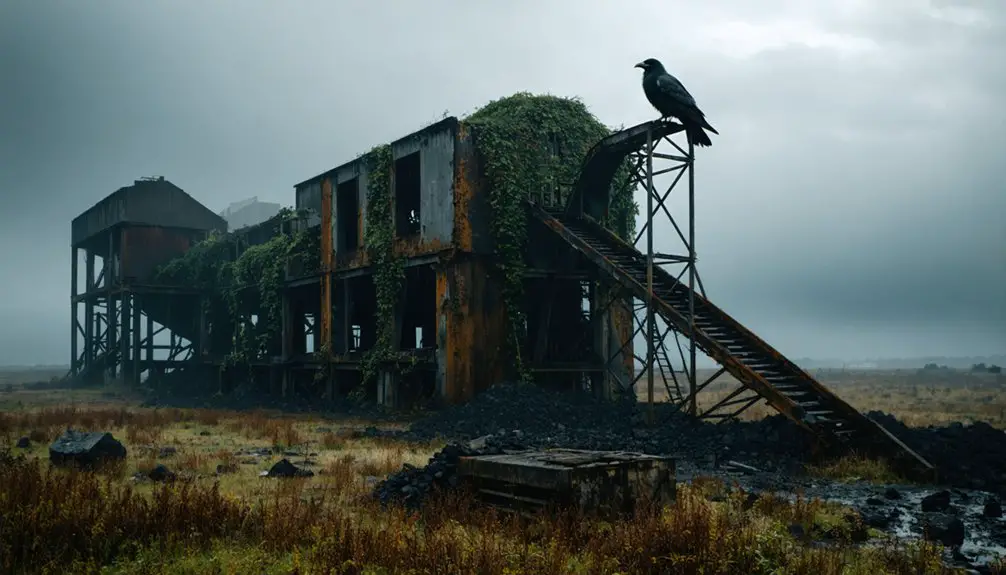
You’ll encounter a rich tapestry of supernatural tales in Meco, where local residents have reported mysterious lights and shadowy figures around the abandoned mine shafts after sunset.
Retired miners’ accounts tell of unexplained noises and eerie encounters in the underground tunnels, which they attribute to spirits of workers who perished in past mining accidents.
The community’s oral tradition keeps these stories alive through generations, preserving accounts of phantom coal trains and ghostly miners’ lamps that still appear on foggy nights.
Supernatural Sightings After Dark
When darkness falls over the abandoned streets of Meco, Pennsylvania, an unsettling array of supernatural phenomena emerges that has captivated paranormal investigators and locals alike.
You’ll encounter ghostly phenomena ranging from protective Native American spirits to more sinister entities that stalk the old railroad tracks. At night, visitors report dramatic temperature drops and cold spots, while spirits communicate through various means, often claiming connections to local family histories.
- Shadowy demonic entities move on knuckles along former rail lines
- A dancing cupboard apparition tied to a murdered servant girl
- Multiple spirits manifest in abandoned duplex houses
- 24-year-old male presence connects to basement family photos
- Protective buckskin-clad Native American guardians oppose dark entities
Miners’ Underground Tales
Throughout generations of coal mining in Meco, Pennsylvania, harrowing tales of survival and tragedy have echoed from the town’s sprawling network of underground tunnels.
You’ll hear stories of miners’ survival strategies passed down through oral tradition – from tapping on walls to communicate during emergencies to rationing supplies when trapped below ground.
The miners developed strong underground camaraderie, forming tight-knit groups that looked out for one another in the face of constant dangers like methane gas, cave-ins, and flooding.
They’d gather in secret locations to share essential knowledge about safe passages and air quality management, while also organizing for better working conditions.
These tales of resilience showcase how Meco’s miners relied on collective wisdom and mutual support to survive the perilous underground world.
Community Folklore Lives On
The ghostly legends of Meco extend far beyond its abandoned mine shafts into the fabric of local culture.
You’ll find community spirits lingering in tales passed down through generations, from the haunting presence of a young girl in a bonnet to the infamous story of 13 witches whose graves supposedly create bumps along Johnson Drive.
Ghostly encounters have shaped the town’s identity, with visitors reporting cold spots, whispers, and unexplained shadows around decaying structures.
- A spectral girl glides among the remaining cottages
- Thirteen witch graves create mysterious bumps in the road
- Eerie cold spots and whispers plague abandoned buildings
- Children’s laughter echoes through empty streets
- Woods surrounding Meco host reported occult gatherings
Preservation Efforts Today
Modern preservation efforts for Meco face significant challenges under Pennsylvania’s Statewide Historic Preservation Plan, which guides stewardship across abandoned mining communities.
You’ll find community involvement playing an essential role, with local historical societies and volunteer groups working alongside state agencies to document and protect what remains of this coal-mining ghost town.
Current preservation strategies include installing safety measures around unstable ground, monitoring structural degradation, and implementing controlled access policies where necessary.
Ongoing preservation work prioritizes public safety through ground stabilization, building monitoring, and careful management of site access.
The Pennsylvania Historical and Museum Commission oversees these initiatives while encouraging public engagement through educational programs.
You can participate in oral history projects that help preserve Meco’s legacy, even as physical preservation faces obstacles like environmental hazards, funding limitations, and private property restrictions that complicate conservation efforts.
Frequently Asked Questions
What Dangerous Wildlife Now Inhabits the Abandoned Town of Meco?
You’ll encounter coyotes stalking abandoned wildlife through ghostly encounters, while wild turkeys, deer, and various birds have claimed this dangerous terrain where unstable ground and toxic gases threaten their survival.
Were Any Paranormal Activities Reported During Meco’s Active Mining Years?
You won’t find verified reports of ghost sightings during Meco’s operational years, though mining folklore likely existed among workers, similar to other Pennsylvania coal towns’ supernatural tales during active mining periods.
Did Any Famous People or Celebrities Ever Visit Meco?
You won’t find any documented celebrity sightings or historical visits to Meco. While nearby ghost towns like Centralia attracted some attention, there’s no evidence of famous people ever visiting Meco specifically.
What Happened to the Cemetery and Burial Records From Meco?
You’ll find no cemetery restoration efforts documented – the burial records vanished with Meco’s decline. Underground mine fires and abandonment left both physical gravesites and documentation lost to time’s unstoppable march.
Were There Any Undiscovered Mineral Deposits Left When Mining Ceased?
You’ll find that geological surveys suggest significant mineral deposits remained unmined, including coal pillars and deeper seams that weren’t economically viable for early mineral exploration technology and mining methods.
References
- https://pabucketlist.com/the-rise-and-fall-of-centralia-pas-toxic-ghost-town/
- https://www.youtube.com/watch?v=Qj5LjacccJ0
- https://www.youtube.com/watch?v=fm3wxSOqlYM
- https://www.youtube.com/watch?v=_u5MUuwynhw
- https://en.wikipedia.org/wiki/Centralia
- https://en.wikipedia.org/wiki/Coal_Region
- https://www.heritagejohnstown.org/attractions/heritage-discovery-center/johnstown-history/history-coal-cambria-county/
- https://www.pa.gov/agencies/dep/programs-and-services/mining/bureau-of-mining-programs/pa-mining-history.html
- https://www.iup.edu/library/departments/archives/coal/coal-culture-timeline.html
- https://guides.libraries.psu.edu/PAMinesandMining/coal
